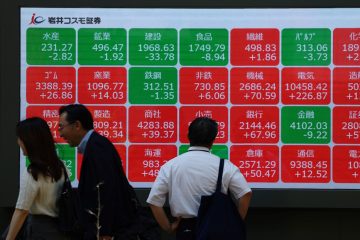The Dow Just Lost Even More Than Bitcoin. But Don’t Call it a Stock Market Crash

The Dow Jones Industrial Average dropped more than 1,000 points for the first time ever Monday. There were only two stocks in the S&P 500 that were up for the day, while all of the Dow’s 30 members fell. Both indexes are now down for 2018, having erased all of their gains for the year.
While Bitcoin, which fell as much as 23% on Monday, shed nearly $ 18 billion in market value during the day, the stock market fared even worse: The Dow stocks alone lost more than $ 300 billion.
In one particularly gory example, Google parent company Alphabet (googl) (which is not in the Dow), lost $ 40 billion of its market cap for the second trading day in a row—meaning Alphabet stock investors have lost more than $ 80 billion since Friday.
But although the Dow’s more than 1175-point drop made the ticker tape look even uglier than it did on the darkest days following Lehman Brothers’ 2008 collapse, it was not a market crash, or even remotely close. Market crashes are generally defined by an abrupt and rapid decline of 20% or more: The 1929 Black Tuesday crash, 1987’s Black Monday, the dot-com bust in 2000, and the ’08 financial crisis all had that in common. (That’s similar to the definition of a bear market, which is when prices are down 20% from their peak, which can happen more gradually.)
And market crashes also have a more mild-mannered sibling, the market correction, which is when prices fall at least 10% from their highs. But we’re not there yet either. Even after a multi-day selloff, spurred in part by Friday’s stronger-than-expected jobs report which sparked fears of an inflation spike, the Dow is only off 8.5% from its all-time-record of 26,616.71 last month, while the S&P 500 is down 7.8% from its high.
After all, the higher the Dow rises, the more likely it is to lose or gain hundreds of points in any given day, simply because the swings represent smaller percentage changes. So although the Dow’s drop Monday was its biggest-ever in terms of points, the index only declined 4.6%. Compare that to October 19, 1987—the infamous Black Monday—when the Dow sank more than 22%, but only 508 points. (Indeed, while the Dow first hit the 20,000 milestone just over a year ago, it wasn’t quite such a big deal when it reached 26,000 less than a year later.)
The Bitcoin price, on the other hand, is most certainly crashing. But then again, that’s nothing unusual for Bitcoin, which has been crashing almost continuously since December and frequently rises or falls as much as 20% in a day.
Still, anyone who owns stocks likely lost money on Monday. Every stock in the Dow was down, and the only two stocks in the S&P 500 that rose were online travel site TripAdvisor (trip), up 3.7%, and baking soda manufacturer Church & Dwight, up 2.4%. (Church & Dwight had reported earnings that beat Wall Street’s expectations Monday morning, while TripAdvisor announced that it would expand its board of directors, adding one of Netflix’s board members.)
The biggest losers? Wells Fargo (wfc) stock dropped more than 9% after the Federal Reserve slapped the bank with new penalties Friday night for various missteps, making it the S&P 500’s worst-performing stock for the day. And Boeing (ba) fell the most of any Dow stock, down nearly 6%, though the airplane maker is still the index’s best performer so far in 2018, up 11.5% year to date.
If the Dow has another bad day tomorrow or shortly thereafter, it may very well still fall into correction territory: It need only lose another 361 points to officially mark a correction.
But that wouldn’t be the worst thing, and in fact, might even be healthy, a long overdue breather in what has otherwise been a raging bull market, now approaching its nine-year anniversary next month. In fact, there have only been four 10% stock market corrections since the recession ended in 2009, according to Yardeni Research.
Nor would a stock market correction be entirely unexpected. Investing experts and economists have been saying for a while that stocks look expensive, and predicting that valuations would have to return to Earth sooner or later. The new Federal Reserve chair Jerome Powell, the successor to Janet Yellen, arrived for his first day of work Monday. Though it’s not clear whether Powell is any more likely to raise interest rates than Yellen was, strong job and wage growth has increased expectations that the Fed will hike rates more quickly than previously anticipated, which could suck some air out of the stock market as Treasury bonds become a more attractive alternative.
Then again, a market correction—or even an intermediary bear market—could just give the stock market a second wind for a continued bull run. Sam Stovall, the chief investment strategist of CFRA, wrote in a research note Monday that the firm does not expect the selloff to “morph into a bear market,” because “we don’t see a recession on the horizon.” If it does, though, CFRA thinks the bear market would last about 14 months—but then only take a little more than four months for a bull market to begin again.
Whatever happens, though, one thing is for sure: Expect the Dow to have a lot more 1,000-point up or down days. Just remember not to panic when it happens.









